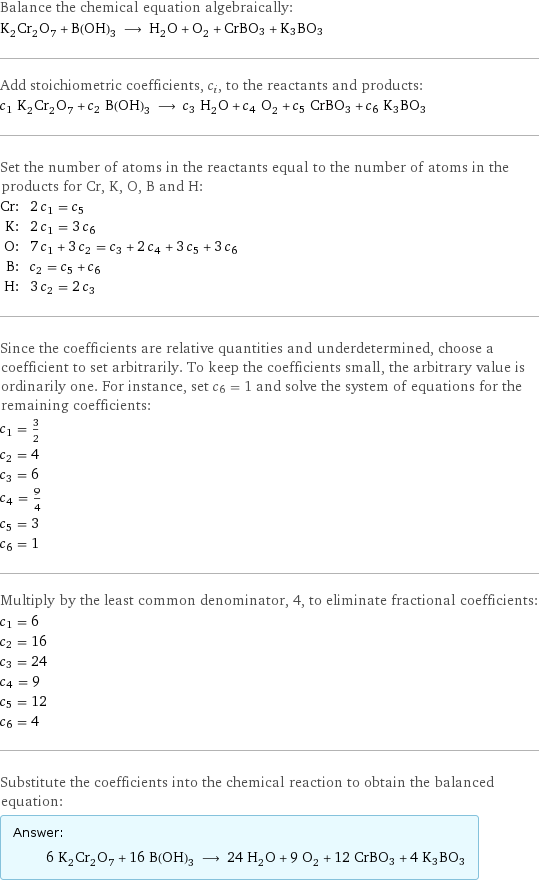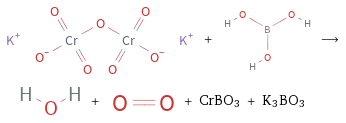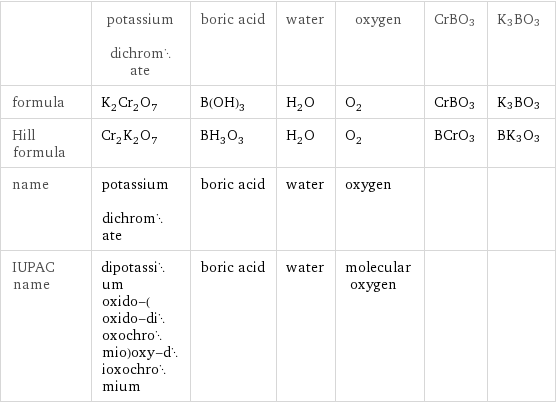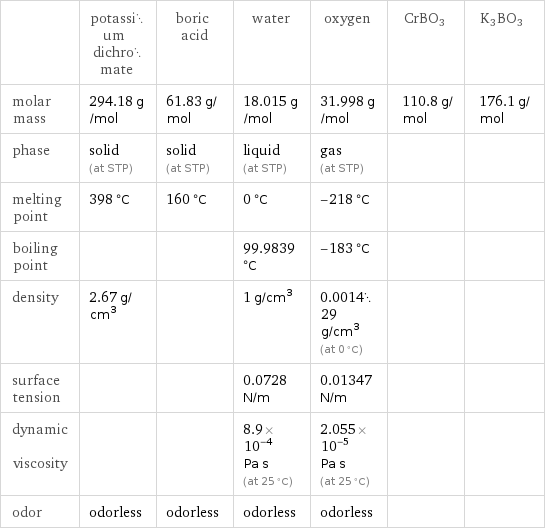Input interpretation

K_2Cr_2O_7 potassium dichromate + B(OH)_3 boric acid ⟶ H_2O water + O_2 oxygen + CrBO3 + K3BO3
Balanced equation

Balance the chemical equation algebraically: K_2Cr_2O_7 + B(OH)_3 ⟶ H_2O + O_2 + CrBO3 + K3BO3 Add stoichiometric coefficients, c_i, to the reactants and products: c_1 K_2Cr_2O_7 + c_2 B(OH)_3 ⟶ c_3 H_2O + c_4 O_2 + c_5 CrBO3 + c_6 K3BO3 Set the number of atoms in the reactants equal to the number of atoms in the products for Cr, K, O, B and H: Cr: | 2 c_1 = c_5 K: | 2 c_1 = 3 c_6 O: | 7 c_1 + 3 c_2 = c_3 + 2 c_4 + 3 c_5 + 3 c_6 B: | c_2 = c_5 + c_6 H: | 3 c_2 = 2 c_3 Since the coefficients are relative quantities and underdetermined, choose a coefficient to set arbitrarily. To keep the coefficients small, the arbitrary value is ordinarily one. For instance, set c_6 = 1 and solve the system of equations for the remaining coefficients: c_1 = 3/2 c_2 = 4 c_3 = 6 c_4 = 9/4 c_5 = 3 c_6 = 1 Multiply by the least common denominator, 4, to eliminate fractional coefficients: c_1 = 6 c_2 = 16 c_3 = 24 c_4 = 9 c_5 = 12 c_6 = 4 Substitute the coefficients into the chemical reaction to obtain the balanced equation: Answer: | | 6 K_2Cr_2O_7 + 16 B(OH)_3 ⟶ 24 H_2O + 9 O_2 + 12 CrBO3 + 4 K3BO3
Structures

+ ⟶ + + CrBO3 + K3BO3
Names

potassium dichromate + boric acid ⟶ water + oxygen + CrBO3 + K3BO3
Equilibrium constant
![Construct the equilibrium constant, K, expression for: K_2Cr_2O_7 + B(OH)_3 ⟶ H_2O + O_2 + CrBO3 + K3BO3 Plan: • Balance the chemical equation. • Determine the stoichiometric numbers. • Assemble the activity expression for each chemical species. • Use the activity expressions to build the equilibrium constant expression. Write the balanced chemical equation: 6 K_2Cr_2O_7 + 16 B(OH)_3 ⟶ 24 H_2O + 9 O_2 + 12 CrBO3 + 4 K3BO3 Assign stoichiometric numbers, ν_i, using the stoichiometric coefficients, c_i, from the balanced chemical equation in the following manner: ν_i = -c_i for reactants and ν_i = c_i for products: chemical species | c_i | ν_i K_2Cr_2O_7 | 6 | -6 B(OH)_3 | 16 | -16 H_2O | 24 | 24 O_2 | 9 | 9 CrBO3 | 12 | 12 K3BO3 | 4 | 4 Assemble the activity expressions accounting for the state of matter and ν_i: chemical species | c_i | ν_i | activity expression K_2Cr_2O_7 | 6 | -6 | ([K2Cr2O7])^(-6) B(OH)_3 | 16 | -16 | ([B(OH)3])^(-16) H_2O | 24 | 24 | ([H2O])^24 O_2 | 9 | 9 | ([O2])^9 CrBO3 | 12 | 12 | ([CrBO3])^12 K3BO3 | 4 | 4 | ([K3BO3])^4 The equilibrium constant symbol in the concentration basis is: K_c Mulitply the activity expressions to arrive at the K_c expression: Answer: | | K_c = ([K2Cr2O7])^(-6) ([B(OH)3])^(-16) ([H2O])^24 ([O2])^9 ([CrBO3])^12 ([K3BO3])^4 = (([H2O])^24 ([O2])^9 ([CrBO3])^12 ([K3BO3])^4)/(([K2Cr2O7])^6 ([B(OH)3])^16)](../image_source/6c5a2491e9f7159f50667e88a27ea8bf.png)
Construct the equilibrium constant, K, expression for: K_2Cr_2O_7 + B(OH)_3 ⟶ H_2O + O_2 + CrBO3 + K3BO3 Plan: • Balance the chemical equation. • Determine the stoichiometric numbers. • Assemble the activity expression for each chemical species. • Use the activity expressions to build the equilibrium constant expression. Write the balanced chemical equation: 6 K_2Cr_2O_7 + 16 B(OH)_3 ⟶ 24 H_2O + 9 O_2 + 12 CrBO3 + 4 K3BO3 Assign stoichiometric numbers, ν_i, using the stoichiometric coefficients, c_i, from the balanced chemical equation in the following manner: ν_i = -c_i for reactants and ν_i = c_i for products: chemical species | c_i | ν_i K_2Cr_2O_7 | 6 | -6 B(OH)_3 | 16 | -16 H_2O | 24 | 24 O_2 | 9 | 9 CrBO3 | 12 | 12 K3BO3 | 4 | 4 Assemble the activity expressions accounting for the state of matter and ν_i: chemical species | c_i | ν_i | activity expression K_2Cr_2O_7 | 6 | -6 | ([K2Cr2O7])^(-6) B(OH)_3 | 16 | -16 | ([B(OH)3])^(-16) H_2O | 24 | 24 | ([H2O])^24 O_2 | 9 | 9 | ([O2])^9 CrBO3 | 12 | 12 | ([CrBO3])^12 K3BO3 | 4 | 4 | ([K3BO3])^4 The equilibrium constant symbol in the concentration basis is: K_c Mulitply the activity expressions to arrive at the K_c expression: Answer: | | K_c = ([K2Cr2O7])^(-6) ([B(OH)3])^(-16) ([H2O])^24 ([O2])^9 ([CrBO3])^12 ([K3BO3])^4 = (([H2O])^24 ([O2])^9 ([CrBO3])^12 ([K3BO3])^4)/(([K2Cr2O7])^6 ([B(OH)3])^16)
Rate of reaction
![Construct the rate of reaction expression for: K_2Cr_2O_7 + B(OH)_3 ⟶ H_2O + O_2 + CrBO3 + K3BO3 Plan: • Balance the chemical equation. • Determine the stoichiometric numbers. • Assemble the rate term for each chemical species. • Write the rate of reaction expression. Write the balanced chemical equation: 6 K_2Cr_2O_7 + 16 B(OH)_3 ⟶ 24 H_2O + 9 O_2 + 12 CrBO3 + 4 K3BO3 Assign stoichiometric numbers, ν_i, using the stoichiometric coefficients, c_i, from the balanced chemical equation in the following manner: ν_i = -c_i for reactants and ν_i = c_i for products: chemical species | c_i | ν_i K_2Cr_2O_7 | 6 | -6 B(OH)_3 | 16 | -16 H_2O | 24 | 24 O_2 | 9 | 9 CrBO3 | 12 | 12 K3BO3 | 4 | 4 The rate term for each chemical species, B_i, is 1/ν_i(Δ[B_i])/(Δt) where [B_i] is the amount concentration and t is time: chemical species | c_i | ν_i | rate term K_2Cr_2O_7 | 6 | -6 | -1/6 (Δ[K2Cr2O7])/(Δt) B(OH)_3 | 16 | -16 | -1/16 (Δ[B(OH)3])/(Δt) H_2O | 24 | 24 | 1/24 (Δ[H2O])/(Δt) O_2 | 9 | 9 | 1/9 (Δ[O2])/(Δt) CrBO3 | 12 | 12 | 1/12 (Δ[CrBO3])/(Δt) K3BO3 | 4 | 4 | 1/4 (Δ[K3BO3])/(Δt) (for infinitesimal rate of change, replace Δ with d) Set the rate terms equal to each other to arrive at the rate expression: Answer: | | rate = -1/6 (Δ[K2Cr2O7])/(Δt) = -1/16 (Δ[B(OH)3])/(Δt) = 1/24 (Δ[H2O])/(Δt) = 1/9 (Δ[O2])/(Δt) = 1/12 (Δ[CrBO3])/(Δt) = 1/4 (Δ[K3BO3])/(Δt) (assuming constant volume and no accumulation of intermediates or side products)](../image_source/7ae6fcb537be31c4d4ea5e73b86d3881.png)
Construct the rate of reaction expression for: K_2Cr_2O_7 + B(OH)_3 ⟶ H_2O + O_2 + CrBO3 + K3BO3 Plan: • Balance the chemical equation. • Determine the stoichiometric numbers. • Assemble the rate term for each chemical species. • Write the rate of reaction expression. Write the balanced chemical equation: 6 K_2Cr_2O_7 + 16 B(OH)_3 ⟶ 24 H_2O + 9 O_2 + 12 CrBO3 + 4 K3BO3 Assign stoichiometric numbers, ν_i, using the stoichiometric coefficients, c_i, from the balanced chemical equation in the following manner: ν_i = -c_i for reactants and ν_i = c_i for products: chemical species | c_i | ν_i K_2Cr_2O_7 | 6 | -6 B(OH)_3 | 16 | -16 H_2O | 24 | 24 O_2 | 9 | 9 CrBO3 | 12 | 12 K3BO3 | 4 | 4 The rate term for each chemical species, B_i, is 1/ν_i(Δ[B_i])/(Δt) where [B_i] is the amount concentration and t is time: chemical species | c_i | ν_i | rate term K_2Cr_2O_7 | 6 | -6 | -1/6 (Δ[K2Cr2O7])/(Δt) B(OH)_3 | 16 | -16 | -1/16 (Δ[B(OH)3])/(Δt) H_2O | 24 | 24 | 1/24 (Δ[H2O])/(Δt) O_2 | 9 | 9 | 1/9 (Δ[O2])/(Δt) CrBO3 | 12 | 12 | 1/12 (Δ[CrBO3])/(Δt) K3BO3 | 4 | 4 | 1/4 (Δ[K3BO3])/(Δt) (for infinitesimal rate of change, replace Δ with d) Set the rate terms equal to each other to arrive at the rate expression: Answer: | | rate = -1/6 (Δ[K2Cr2O7])/(Δt) = -1/16 (Δ[B(OH)3])/(Δt) = 1/24 (Δ[H2O])/(Δt) = 1/9 (Δ[O2])/(Δt) = 1/12 (Δ[CrBO3])/(Δt) = 1/4 (Δ[K3BO3])/(Δt) (assuming constant volume and no accumulation of intermediates or side products)
Chemical names and formulas

| potassium dichromate | boric acid | water | oxygen | CrBO3 | K3BO3 formula | K_2Cr_2O_7 | B(OH)_3 | H_2O | O_2 | CrBO3 | K3BO3 Hill formula | Cr_2K_2O_7 | BH_3O_3 | H_2O | O_2 | BCrO3 | BK3O3 name | potassium dichromate | boric acid | water | oxygen | | IUPAC name | dipotassium oxido-(oxido-dioxochromio)oxy-dioxochromium | boric acid | water | molecular oxygen | |
Substance properties

| potassium dichromate | boric acid | water | oxygen | CrBO3 | K3BO3 molar mass | 294.18 g/mol | 61.83 g/mol | 18.015 g/mol | 31.998 g/mol | 110.8 g/mol | 176.1 g/mol phase | solid (at STP) | solid (at STP) | liquid (at STP) | gas (at STP) | | melting point | 398 °C | 160 °C | 0 °C | -218 °C | | boiling point | | | 99.9839 °C | -183 °C | | density | 2.67 g/cm^3 | | 1 g/cm^3 | 0.001429 g/cm^3 (at 0 °C) | | surface tension | | | 0.0728 N/m | 0.01347 N/m | | dynamic viscosity | | | 8.9×10^-4 Pa s (at 25 °C) | 2.055×10^-5 Pa s (at 25 °C) | | odor | odorless | odorless | odorless | odorless | |
Units
